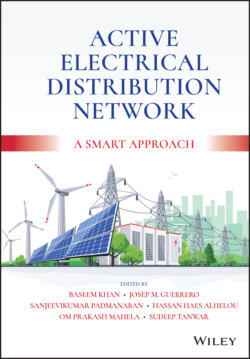Читать книгу Active Electrical Distribution Network - Группа авторов - Страница 76
4.1 Introduction
ОглавлениеWith increased industrialization and power demand, power engineers are looking for new and efficient ways for power generation and their sources. For this, renewable energy (RE) technologies are the best and most promising option/answer, along with an advantage of reduced carbon emissions [1]. Battery energy storage systems (BESSs) have been proved to be an efficient emerging technology for short-term power storage for power utilization for mitigation of various power quality (PQ) disturbances, stability, reliability, and protection [2–5].
In the current scenario, the demand for good quality of power in the distribution grid enhances significantly due to frequent use of smart equipment. These types of equipment are the primary cause of harmonics. This distribution equipment draws distorted sinusoidal current and behaves as nonlinear loads, which deteriorates the quality of supply in the network of the distribution grid [6]. Thus, PQ is defined by any deviation in frequency, voltage quality, and current quality of the electrical signal [7]. The major PQ issues include a low power factor, unbalanced voltage, reactive power requirement, and harmonics level in three-wire distribution systems. These issues generally originate due to the proliferation of nonlinear loads. It causes mal operation, failure, or damages of smart electrical equipment of the distribution network [8]. Hence, the nature of the distribution load at the point of common coupling (PCC) is of significant concern when analyzing the impact of the utility network performance given PQ in compliance of the IEEE 519-2014 standard [9].
Literature details the various smart solutions for the aforementioned problems in the distribution system. For this purpose, research on different design architectures of BESS for power quality application is under development [10]. The battery integrated with FACTS devices is one of the smart solutions for the distribution network [11, 12]. Also, there can be various topologies of the converters like a four-quadrant converter topology with which bidirectional energy flow can be achieved. The voltage source converter (VSC) has been used for modulating the energy flow in mostly BESS controllers for controlling active and reactive power simultaneously and independently [13]. An adequate charge controller is needed for appropriate charging of the battery, for when a battery is fully charged (constant voltage), its charge acceptance capability and charging current are both reduced [14, 15]. Thus, it takes a long time for full charging at a constant voltage. Hence, various control algorithms have been proposed in the literature, such as an instantaneous current control theory for PQ conditioning with BESS [16], a synchronous reference frame control theory for PQ mitigation in the presence of motor load [17], an adaptive linear element-based control for PQ improvement in the presence of multifarious loads [18], a least mean control algorithm for PQ mitigation in a weak grid environment with inductive nature loads [19], and application of a control algorithm for RE power generation [20,21] for power quality mitigation and maximum power extraction. Moreover, the performance comparisons of these algorithms have been presented in [22] for the power quality application.
Apart from all the control algorithms, as mentioned above, indirect current control theory (ICCT) has the additional ability for fast regulation of the battery charging level and distributed system stability for transient conditions. Also, the proposed control algorithm provides a constant DC link voltage with fewer fluctuations.
This chapter aims to design an ICCT controlled DSTATCOM-BESS configuration for power conditioning in a distribution system with a balanced and unbalanced linear, nonlinear, and induction motor load. This detailed analysis helps beginners in selecting the type of load for the specific BESS-based configuration. The basic configuration of ICCT controlled DSTATCOM-BESS system is illustrated in Figure 4.1.
Figure 4.1 ICCT controlled DSTATCOM-BESS system connected at PCC.
